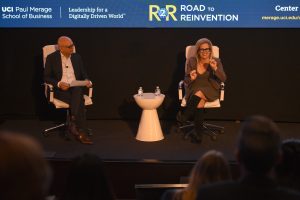Taco Bell is Just Getting Started in the Digital Space, Says Marisa Thalberg, Global Chief Brand Officer by CDT

A series of highly accomplished athletes, professionals and artists speak their dreams at the beginning of the Taco Bell commercial.
I dream of reaching my highest peak, says a mountain climber. I dream of expressing my inner most passion, says a ballerina. I dream of robotics that improve quality of life for humans, says a scientist.
I dream of getting my Taco Bell delivered, like, to my house, says actor and comedian Adam Devine.
At the end, the professionals are left to express profuse devotion to their craft. Meanwhile, Devine’s dreams are met with a happy ending. His phone dings, alerting him to a notification from GrubHub that reads: Your Taco Bell delivery has arrived.
We’re doing it guys, DeVine says triumphantly. Achieving our dreams!
The commercial helped inform consumers that Taco Bell’s parent company, Yum! Brands, had recently entered a strategic partnership with Grubhub to ensure a seamless delivery experience, Marisa Thalberg, Global Chief Brand Officer at Taco Bell, said at the Road to Reinvention conference in March. The conference is hosted by the Center for Digital Transformation at the UCI Paul Merage School of Business.
The quick service restaurant industry is just beginning to enter the digital landscape, Thalberg said.
“E-commerce solves convenience, access and speed, but those are already the fundamentals of Taco Bell and the fast food service industry,” Thalberg explained. “But e-commerce can make an impact by allowing customers to save preferences and customize their meal more easily.”
In fact, one of Thalberg’s earliest contributions to Taco Bell was defining a strategy and vision for the digital age. She came to the conclusion that Taco Bell needed to be more than a cravable, Mexican-style food brand. In order to survive, it needed to be a culture-centric brand, generating a lifestyle for its followers.
To that end, Taco Bell recently collaborated with Forever 21 to create clothing that represents the brand. In addition, the brand built a wedding venue at their Vegas location, where more than 160 weddings have since taken place.
Those actions offer insight into Taco Bell’s branding strategy. The company treats itself like a mass brand, honoring the fundamentals of affordability, convenience, speed, value and ubiquity, but shows up and behaves in a way that reflects a cult, indie brand.
“There’s a difference between having fun with something, having a twinkle, versus making a joke out of it,” Thalberg said. “For example, the Grubhub commercial is executed with the recognition that we believe our customers are smart, and they’re in on the joke with us.”
A series of highly accomplished athletes, professionals and artists speak their dreams at the beginning of the Taco Bell commercial. I dream of reaching my highest peak, says a mountain climber. I dream of expressing my inner most passion, says a ballerina. I dream of robotics that improve quality of life for humans, says a scientist. I dream of getting my Taco Bell delivered, like, to my house, says actor and comedian Adam Devine. At the end, the professionals are left to express profuse devotion to their craft. Meanwhile, Devine’s dreams are met with a happy ending. His phone dings, alerting him to a notification from GrubHub that reads: Your Taco Bell delivery has arrived. We’re doing it guys, DeVine says triumphantly. Achieving our dreams! The commercial helped inform consumers that Taco Bell’s parent company, Yum! Brands, had recently entered a strategic partnership with Grubhub to ensure a seamless delivery experience, Marisa Thalberg, Global Chief Brand Officer at Taco Bell, said at the Road to Reinvention conference in March. The conference is hosted by the Center for Digital Transformation at the UCI Paul Merage School of Business. The quick service restaurant industry is just beginning to enter the digital landscape, Thalberg said. “E-commerce solves convenience, access and speed, but those are already the fundamentals of Taco Bell and the fast food service industry,” Thalberg explained. “But e-commerce can make an impact by allowing customers to save preferences and customize their meal more easily.” In fact, one of Thalberg’s earliest contributions to Taco Bell was defining a strategy and vision for the digital age. She came to the conclusion that Taco Bell needed to be more than a cravable, Mexican-style food brand. In order to survive, it needed to be a culture-centric brand, generating a lifestyle for its followers. To that end, Taco Bell recently collaborated with Forever 21 to create clothing that represents the brand. In addition, the brand built a wedding venue at their Vegas location, where more than 160 weddings have since taken place. Those actions offer insight into Taco Bell’s branding strategy. The company treats itself like a mass brand, honoring the fundamentals of affordability, convenience, speed, value and ubiquity, but shows up and behaves in a way that reflects a cult, indie brand. “There’s a difference between having fun with something, having a twinkle, versus making a joke out of it,” Thalberg said. “For example, the Grubhub commercial is executed with the recognition that we believe our customers are smart, and they’re in on the joke with us.”
